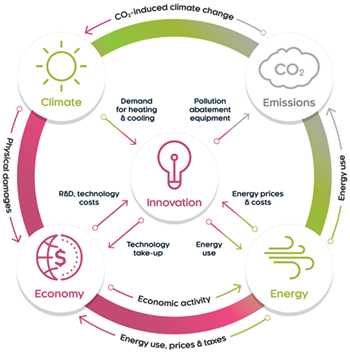Capturing real economy effects, CO2 emission levels and sector impacts with a global recognized macroeconometric model
Ortec Finance’s ClimateMAPS - climate scenario analysis solution utilizes Cambridge Econometrics’s advanced E3ME model to incorporate a comprehensive range of climate-related transition risk drivers, including low-carbon regulatory and fiscal policies, technology uptake, energy demand and emissions at country and sector levels in its Ortec Finance Climate Scenarios.
This approach facilitates a real-world assessment of how the low-carbon transition will affect financial markets but also generates additional insights to identify how opportunities and risks may differ across regions and sectors.

Ortec Finance has exclusive rights to access E3ME within its proprietary climate scenario modeling, as part of a longstanding partnership with Cambridge Econometrics established in 2019.
Why we utilize E3ME to assess climate transition risks
![]()
Capture the effects of the low-carbon transition on the real economy at a highly granular sector and regional level
![]()
Model the impact of a wide range of policies to reduce CO₂ emissions for individual countries
![]()
Model the dynamic take-up of technologies, taking account of real-world frictions
![]()
Account for worldwide macro-economic interactions and industry supply chain interdependencies
![]()
Realistically represent the financial sector in a way that allows for investment stimulus effects via its non-equilibrium modeling approach
Applying E3ME in ClimateMAPS
The data generated from E3ME is integrated with our Economic Scenario Generator and extreme weather (acute physical risk) modeling tool to quantify climate change risks and opportunities across all asset classes, macroeconomic variables and sectors.

About ClimateMAPS

About Cambridge Econometrics
Cambridge Econometrics is an award-winning economics consultancy based in Cambridge (UK), Brussels, Budapest and Northampton, Massachusetts. Their globally recognised macroeconomic model E3ME underpins its rigorous and independent approach to helping clients make evidence-based investment and policy decisions with confidence, providing clear, intelligent and actionable insights.
E3ME fuels Cambridge Econometric’s strategic partnership with Ortec Finance through simulating interactions and dynamics of the economy for climate scenario analysis, testing the impact of different global temperature pathways and assessing the impact of physical and transitional climate-related risks.
Contact




